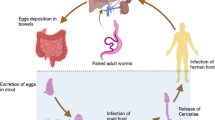Abstract
Several biological factors are involved in susceptibility and resistance to murine cysticercosis. A substantial body of evidence implies prostaglandins as potent regulators of immune responses during parasitic diseases. Here we evaluated the role played by prostaglandin E2 in cysticercosis. Mice were treated in vivo with prostaglandin E2 or with indomethacin (a prostaglandin E2 synthesis inhibitor) before infection. Parasite growth was enhanced by prostaglandin treatment, which provoked poor Con-A responses, low Th1-type cytokines secretion, and high levels of IL-6 and IL-10. In contrast, mice receiving indomethacin showed a reduction in parasite load parallel to a strong Con-A response and high levels of IL-2 and IFN-γ, concomitantly with a decrease in IL-4, IL-6 and IL-10 production. Indirect in vitro studies suggest that an important source of prostaglandin E2 production could be related to host's adherent cells. However, prostaglandin E2 from parasite origin cannot be discarded.
Similar content being viewed by others
Author information
Authors and Affiliations
Rights and permissions
About this article
Cite this article
Terrazas, L., Bojalil, R., Rodriguez-Sosa, M. et al. Taenia crassiceps cysticercosis: A role for prostaglandin E2 in susceptibility. Parasitol Res 85, 1025–1031 (1999). https://doi.org/10.1007/s004360050676
Issue Date:
DOI: https://doi.org/10.1007/s004360050676




